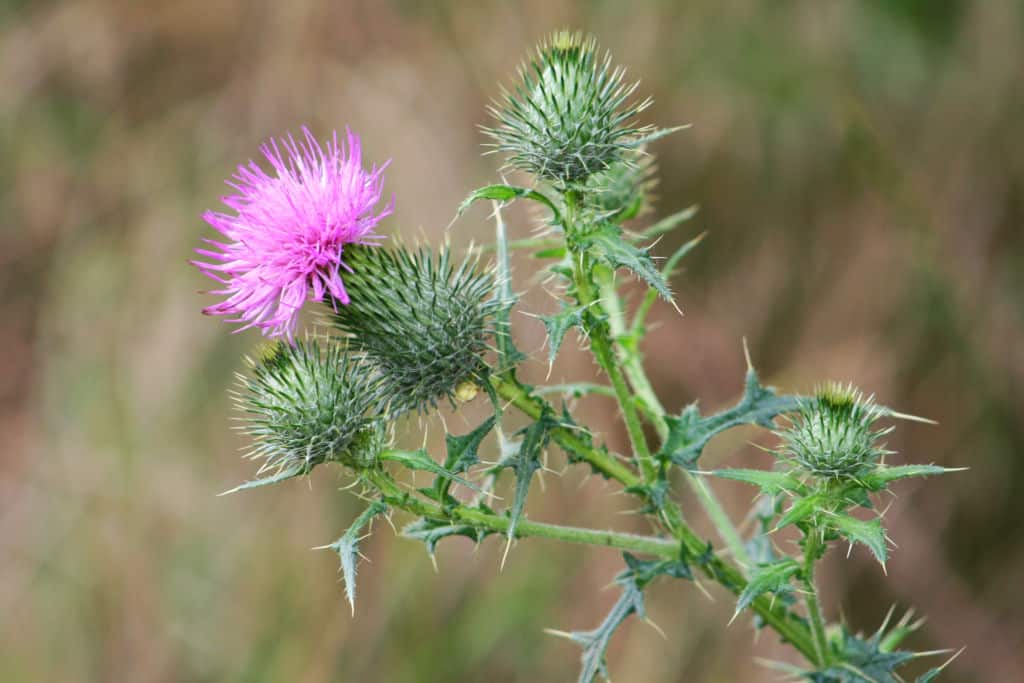If you’re looking to get rid of a couple of plants or an entire area of weeds, then Roundup/Glyphosate is probably your best choice. It blocks the plant’s ability to build amino acids, but it needs time to work its way from the leaves into the root of the plant. How long does it take to work?
RoundUp takes anywhere from 12 hours to 7 days to work, depending on the product. The more you rely on higher concentrations of glyphosate, the better the job. But, it takes at least a week for glyphosate to start working through the plant.
Glyphosate, the main ingredient of Roundup, is one of the most effective and safest options available. It kills weeds efficiently without damaging the soil. It doesn’t leave any residual effect in the soil if used in moderation.
Keep in mind that if your Roundup product has Diquat or pelargonic acid in addition to glyphosate, it may reduce the efficacy of glyphosate.

How Long for Roundup to Work?
Glyphosate, the key ingredient of Roundup, takes at least a week to work, but some versions of Roundup have other substances that burn the upper parts of plants in just a few hours. This may not be the best solution, because the roots might still be alive.
Research suggests that, for Roundup to reach the deepest parts of the root system, allowing for at least 10-14 days post-application ensures the glyphosate has penetrated thoroughly.
Mowing and tilling won’t kill the weeds off completely. This is why glyphosate is used, but it needs time to work its way through the plant. This is because of how glyphosate works.
Glyphosate kills the plant by getting into its root system through the leaves (or any upper part of the plant). It doesn’t poison the soil, instead, it works systematically through the plant essentially shutting off the process of amino-acid production. If you don’t wait until the roots are completely dead, then when you remove the weeds, it can still grow back.
Even though the leaves might start to wilt or change color after a few days, it’s crucial to wait, as this is a sign that the glyphosate is traveling down towards the roots, doing its systemic job.
There are several versions of Roundup (containing glyphosate):
- Roundup Super Concentrate (white bottle, purple cap). Probably your best choice of Roundup. Because it relies only on glyphosate, it takes 7-10 days to work. Takes time, but does the job well. No soil residual, no root uptake. You can use it safely on your driveway, sidewalk, patio, etc.
- Roundup Concentrate Plus – (white bottle, red cap). Containes glyphosate and diquat dibromide. Works faster (12 hours to work). Works faster but doesn’t give glyphosate time to work and kills the roots as well.
- Roundup Ready-to-Use Plus – (blue/white bottle). Contains pelargonic acid. Works fastest (3 hours to work). This one burns the plants down but may not get rid of the roots as well.
Basically, if you saw results any sooner than a few days, you were using a roundup with a diquat or the one with pelargonic acid. To remove the sod completely, look into sod removal tools.
The cool thing about glyphosate is that it doesn’t get into or spread through the soil. It doesn’t poison it, kills the weeds completely, and is safe to use in moderation. It may also increase your property value, by making your lawn more attractive. Be sure always to read the label to know what you’re dealing with and how to use it properly.
Remember that if you overspray on the grass next to it, it will also kill that grass. Protect any nearby plants that you do not want to be damaged.
Roundup with glyphosate works best in warmer temperatures. If you’re looking to kill the weeds in January or February, it may do that in a warm period, but it may not be as effective. Moreover, it may not kill any future growth of weeds on that soil. For that, you’ll need a tiller, which breaks up the compact soil to be ready for planting.
Roundup Instructions (How to Use Roundup)
As a precaution, wear gloves, avoid skin contact and wash your hands afterward. Here are general Roundup (with glyphosate) instructions:
- If needed, protect any nearby plants.
- Apply during a warm period, on a sunny day, at least 24h before rain.
- Work methodologically on your lawn, and spray the plants, not the mulch.
- If killing grass, only spot spray the grass that is showing.
- Wait a week and see if you need to apply again.
- Wait two weeks then pull out the plants, or mow down to the ground.
- Rake it up, by hand or a by using a power rake.
Note: For Ivy or any other difficult to rid of the plant, you may need to apply twice. This may take 3-4 weeks.

When using Roundup, it’s crucial to factor in the type of soil you’re dealing with. While glyphosate doesn’t stay in the soil, sandy soils can cause the chemical to wash away more quickly than loamy or clay soils, affecting its efficacy.
When to Apply Roundup?
Weed control works best when the nighttime temperatures don’t fall below 49 degrees F (9.4°C) and should be avoided if they go below 40 degrees. General advice is to spray on a sunny day, possibly earlier on sunlight, so the plants have the time to soak it up. Apply at least 24 hours before the rain, to protect the environment and prevent rain from washing it off the treatment area.
How Long Does It Take for Roundup to Dry?
Roundup needs only 30 minutes up to 3 hours of dry time to be effective. Roundup (with glyphosate) dries out quickly in the sunlight, but always check the instructions on the packaging.
How to Spray Roundup?
You do not want to spray all your soil, just the unwanted plants poking out, weeds you don’t want, etc. If you spray all the mulch, it’s a waste of product because glyphosate doesn’t move through the soil.
One more thing to consider when applying Roundup is the growth stage of the weeds you are targeting. Roundup is most effective when applied to young, actively growing weeds, rather than mature or dormant weeds. This is because young plants have a higher rate of absorption and translocation of the herbicide, which allows it to effectively kill the plant down to the roots.
Finally, it’s a good idea to research and identify the specific weeds you are targeting before applying Roundup, as some weeds may be more resistant to glyphosate than others.
For instance, some common weeds like lambsquarters, common ragweed, and giant ragweed have developed resistance to glyphosate. If you’re dealing with these types of weeds, you may need to apply Roundup in conjunction with other weed control methods or consider using a different herbicide altogether.
On the other hand, weeds like chickweed, clover, and dandelion are more susceptible to glyphosate and can be effectively controlled with Roundup alone.
Should you mow before applying Roundup?
Many homeowners advise not to mow before applying Roundup. The benefit of mowing beforehand is that you’ll have less mess to clean. However, mowing will decrease the surface area of the leaves, reducing the amount of poison the plant will take in. It’s your choice on this one.
Keep in mind, if there is “Diquat”, also called ‘diquat dibromide’, as an additional ingredient in your Roundup product it may reduce glyphosate efficacy. It may actually work faster on the top of the plant but won’t give glyphosate enough time to kill the whole plant including the roots. Diquat damages only parts of plants to which it is applied. Glyphosate kills an entire plant systematically.
The best thing is to wait 7 days to see the effect.
Note: Don’t breathe the Roundup in, don’t swallow it, and don’t spray yourself with it. Obviously, this is a given when using any kind of herbicide, but doesn’t hurt to keep it in mind.

How Long Does It Take For Weeds to Die After Spraying?
Using Roundup with glyphosate takes 8-10 days for the weeds to die off, as it works through the plant’s root system. Other herbicides may burn the plant down, but don’t eliminate the roots. Roundup with diquat or other mixtures damages weeds fast, but glyphosate works through the entire plant including the roots.
After a week or so, you can pull the weeds out or reapply if needed.
How Long Does Roundup Stay in Soil?
Roundup (assuming glyphosate) is non-persistent in soils, plants, and water. This means that it gets broken down biologically in a few weeks, mostly for food by microorganisms. One study found that it takes a few days, up to several weeks for 50% of glyphosate to degrade in a treatment site.
This means that after a few weeks, any significant amount of toxicity will be gone, and it should be safe to plant. Warm, moist soils rich in organic matter will degrade glyphosate the fastest.
Glyphosate is also unlikely to poison the groundwater because it binds tightly to the soil. However, like any other product, it’s important for the environment not to overuse it, especially over a large area. Multiple, one-time treatment is fine. Excessive usage throughout the year may not be.
Why is Roundup with glyphosate so effective?
Roundup is so effective because glyphosate kills unwanted plants systematically. It goes into the plant through the leaves, then works its way into the root system of a plant.
If you used glyphosate only, then any toxic residue left in the soil after a few weeks is of no toxicological significance.
Roundup Not Working? What to do?
If you think Roundup is not working, then first make sure you’ve waited at least 8 days.
Takes a week for plants to turn yellow, and after two to three weeks the weeds should be dead. If they are not, then apply again. Glyphosate is highly effective, it just needs time to work its way through the plant.
It may still be better than simply using a tiller because the new plants can easily be choked out by weeds. Best to get rid of those weeds first.
If you still want to avoid Roundup, then you may need to burn certain types of weeds, otherwise, they simply cannot die. You slice them in two, and you make two new weeds. Can be tiresome.
How Long Does Roundup Last?
RoundUp (Glyphosate) can be stored for about 4 years in its original container on the shelf.
However, after mixing with water, Roundup should be used in a reasonable length of time, or the glyphosate can form a sort of a jell in the sprayer. But even in this form, you may still use it for its intended purpose.
Therefore, in general, Roundup doesn’t expire or go bad for at least 4 years.
FAQs
How long should I wait before planting after using Roundup?
After spraying Roundup, it’s recommended to wait at least 7 days before planting anything in the treated area. Glyphosate breaks down rapidly in the soil and doesn’t leave any lasting residue, but waiting for a week after application ensures that the herbicide has time to work and any residual herbicide is fully broken down.
Is Roundup Safe to Use Around Pets?
Roundup can be harmful to pets if they touch or eat plants that are still wet with spray. While glyphosate is low in toxicity, other ingredients in Roundup products can increase toxicity. Animals should not chew on plants treated with Roundup. It’s best to wait for rain before letting pets on treated grass. Roundup is less toxic than many herbicides and won’t spread into the soil, making it safe to remove the treated plants after two weeks.
Does Roundup damage other plants?
Roundup is a non-selective herbicide, which means that it can potentially damage or kill any plant it comes into contact with, including desirable plants. It’s important to avoid overspraying onto nearby plants that you want to keep, as even small amounts of Roundup can harm them.
Is there anything I can do to make Roundup work faster?
Roundup works best when applied to young, actively growing weeds, but there are no recommended methods for making it work faster. Applying too much Roundup can be wasteful and potentially harmful to the environment, while applying too little may not effectively control the weeds.
What are some alternatives to Roundup?
There are several alternatives to Roundup, including vinegar, salt, boiling water, and commercial herbicides containing natural ingredients like citric acid or clove oil. Additionally, cultural methods like manual weeding, mulching, and using cover crops can be effective for weed control in some situations.





